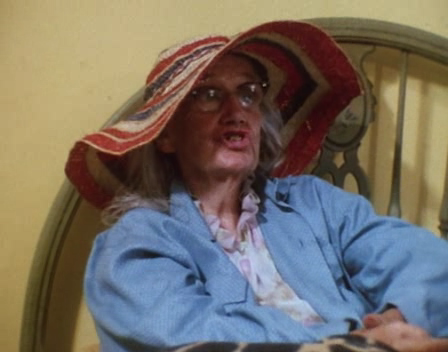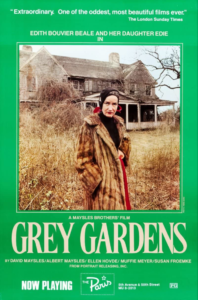|
Genres, Themes, Actors, and Directors:
- Documentary
- Grown Children
- Nonconformists
Review:
After the success of their documentary chronicling the Rolling Stones’ tragic Altamont Speedway concert (1970’s Gimme Shelter), the Maysles brothers set out to make a film about Jacqueline Kennedy Onassis’s childhood — but their attention was diverted once they discovered the existence of Kennedy’s unbelievably eccentric aunt and cousin, “Big” and “Little” Edie Beale. The result was this beloved cult film, in which the Beales allow their quirky, unconventional existence together in a large decaying mansion to be recorded for the general public. Indeed, both Edies are exhibitionists, and seem to take genuine delight in “performing” for the camera: Big Edie considers herself a world-class singer, while Little Edie foster dreams of a dancing career, and we get to witness ample evidence of both their “talents”.
Viewers and critics often wonder whether the Beales — who come across as not-just-a-little unhinged here — were taken advantage of by the Maysles, but in truth, the Beales were flattered by the film, and enjoyed the notoriety it brought them; as a result of her newfound fame, Little Edie — always seeking the limelight — was even given the opportunity to perform in a nightclub. Diehard Beales fans have long championed this documentary, giving it automatic cult status, but it’s gained even more attention recently given the airing of an HBO special (starring Jessica Lange and Drew Barrymore) which fills in the gaps of the Beales’ lives pre-squalor, and serves as an invaluable counterpart to this film; both are must-see.
Redeeming Qualities and Moments:
- Remarkably quirky “performances” by both Big and Little Edie

- Countless humorous scenes — such as when Little Edie describes her “costume for the day”

- Many bizarrely memorable quotes:
“He always compliments me on the way I do my corn.”
“Of course, I’m mad about animals, but raccoons and cats become a little bit boring.”
“You know, they can get you in East Hampton for wearing red shoes on a Thursday.”
Must See?
Yes, as a certifiable cult favorite. Listed as a Cult Movie in the back of Peary’s book.
Categories
Links:
|



One thought on “Grey Gardens (1975)”
A once-must.
Though I’ve seen this doc a number of times (sometimes with others, sometimes not), I’ve never really been able to find anything in it the least bit humorous. ~and I know the ‘humor’ aspect is what gives the film at least some of its cult appeal.
I can never seem to get past the sadness of the situation: a mother and daughter who (at least from what we’re subjected to) share a horribly neglected house – miserable and ignored even after it’s been cleaned-up – while living separate internal realities. They never really carry on a conversation and mostly talk over each other, with the daughter often raising her voice in order to dominate, drown out what her mother is saying, thus maintaining that her view of things is the correct one. What they say reads as qualifying footnotes on each other’s personal truth.
Mom is resigned to reliving her memories; the ‘child’ swims almost ceaselessly in regret. One senses that the two probably quarrel a lot more than we are actually shown. (And what we’re shown of that isn’t pleasant.) At one point, when the daughter goes off on a particular tirade, mom tells the Maysles Brothers to turn the cameras off cause what the daughter is saying is “nuts”. Although one hesitates to make a snap judgment, given the daughter’s overall behavior throughout, a certain definition of ‘nuts’ does seem to apply. I mean, it’s not simply eccentric – Little Edie (who has the most peculiar phobia about her hair – all those wrap-around scarves!) comes off a lot less grounded than her mother.
Part of the cult appeal may come from the verbal fisticuffs (and sometimes you really have to prick up your ears to catch what mom is countering with). No doubt, what comes out of these two mouths can often get a viewer response of “Did she really just say that?” But much of what we see can be rather depressing: i.e., all those very confused-looking cats who are fed but seem to get no affection; the raccoons, etc., fed mountains of cat food and bread on the floor of the attic (!)
One can be rather hard-pressed to know what to make of this doc. A lot of gaps are left here, tho it’s not that difficult to come up with a general conclusion. (And, yes, the Lange/Barrymore follow-up does enlighten and is recommended.) But what are we to take from it? “Don’t let this happen to you!”?!
…Well, it seems some creative artists knew what to take from it…and turned it into a Broadway musical!